Strategize, Execute, Succeed: Creating a Content Marketing Roadmap [Examples and Steps]

Sorry, there were no results found for “”
Sorry, there were no results found for “”
Sorry, there were no results found for “”
What’s the one thing that can turn any night into a nightmare for marketers?
You guessed it: transforming their marketing vision into actionable tasks, objectives, and strategies.
This is precisely where a content marketing roadmap comes into play. It gives you the opportunity to weave every piece of content or messaging you produce into the narrative of your product’s value. Plus, you also get to analyze how your teams come together to communicate the value to your target audience.
Designing a content marketing roadmap isn’t the easiest job, though. In order to take the right strategic direction, you have to build complex roadmaps that align processes across cross-functional teams.
This comprehensive guide will narrow down everything about a content marketing roadmap. We’ll explore common concepts and a pragmatic six-step approach to designing the perfect roadmap for your upcoming marketing activities. 📈
A content marketing roadmap is a visual representation of your marketing objectives, strategies, and tasks over a specific period of time. It serves as a strategic planning tool that helps you organize and prioritize your marketing efforts in order to achieve your overall business goals.
With a well-designed roadmap, you can clearly outline the steps needed to successfully execute your marketing plan and track progress along the way. It also allows you to easily communicate your marketing vision and objectives to your cross-functional teams, ensuring everyone is on the same page and working towards a common goal.
Creating content marketing roadmaps is typically a collaborative effort. The idea is to craft a comprehensive content marketing roadmap that reflects the primary business objectives and process maps with the help of key stakeholders, such as:
The range of collaborators has largely expanded in the past two decades as most teams now have a digital content marketing roadmap with focus on social media messaging and multi-platform performance.
A user-friendly and actionable content marketing roadmap requires several crucial elements. Here are five noteworthy ones:
Now that we understand what a content marketing roadmap is and its essential elements, let’s take a look at the different types of roadmaps you can create:
The Product Launch Roadmap focuses on outlining the content strategy for introducing new products or features to the market. It involves detailed planning of content creation and distribution across various channels with the objective of creating buzz and educating potential customers about the new offering. This type of roadmap includes timelines for teaser content, launch announcements, educational content, and post-launch follow-up to keep the audience engaged.
A Brand Awareness Roadmap is designed to increase the visibility and recognition of your brand among your target audience. Using a mix of content types, such as blog posts, social media content, video marketing, and influencer collaborations, this roadmap aims to tell your brand’s story, convey its values, and connect emotionally with potential customers. Key metrics for success in this roadmap might include social media engagement rates, website traffic from organic search, and media mentions.
The Lead Generation Roadmap lays out a content marketing strategy for attracting and converting leads through content marketing efforts. It focuses on creating and distributing content that adds value to your target audience, thereby encouraging them to provide their contact information in exchange. This type of roadmap heavily relies on content like downloadable guides, webinars, and email marketing sequences designed to nurture leads through the sales funnel.
This roadmap is all about keeping your existing customers engaged and loyal to your brand. The Customer Retention Roadmap involves creating content that adds continuous value, educates on the use of your products or services, and keeps customers updated on new developments. Content formats may include email newsletters, loyalty programs, and exclusive offers. The goal is to foster a strong community around your brand, reducing churn and increasing customer lifetime value.
Now that we’ve established the foundational insights, it’s time to delve into the step-by-step process for designing your next successful content marketing roadmap.
To be fair, creating content marketing roadmaps requires an extensive cycle of planning and execution. That’s why we’ve narrowed this into six distinct steps, making the creation of an effective content marketing roadmap straightforward and manageable. Let’s take a look.👇
First things first, come up with a content marketing plan that works for you as that’s the cornerstone of all that you’ll do ahead. Generally, the effectiveness of every content marketing strategy relies on aligning goals with overarching business priorities. For instance:
Apart from money and resources, time remains a crucial factor in creating content marketing roadmaps. So, factor in these components wisely and plan ahead of time to avoid any discrepancies later.
To help companies excel right from the planning stage, ClickUp, a top-rated marketing and project management solution, offers all the functionalities you need in one place. From outlining business objectives to setting up timelines, the AI-powered platform can support you through it all.

ClickUp’s AI functions make it simple for marketing teams to quickly produce important documents like a case study
ClickUp hosts a variety of content marketing roadmap templates to help you every step of the way. These templates come with preset structures that allow teams to set measurable objectives from the get-go. You can further adjust timeframes (like Day, Week, or Month) depending on the type of your marketing project.
New a quick base to get started? Employ the ClickUp Roadmap Whiteboard Template! It simplifies the creation of visually engaging game plans for projects or products, thanks to features like:

Create a content creation process for your project or new product life cycle on ClickUp’s whiteboard. Keep track of team members involved and use the finished roadmap as a guide for future project management.
Crafting an effective content marketing roadmap requires a thorough understanding of your market dynamics and audience preferences.
This research phase is foundational, offering important insights for your content marketing strategy. It unveils customer desires and competitor strategies, enriching your marketing approach with a comprehensive knowledge of the industry landscape.
Kicking off the groundwork for your marketing strategy, this step requires exploring three pivotal elements: audience insights, brand evaluation, and competitive analysis.
This data forms the bedrock of your content marketing roadmap. Make an effort to understand your demographics and their behaviors, pain points, and interests. In B2B scenarios, insight into their decision-making processes gives you an upper hand in formulating effective communication strategies.
Conduct a comprehensive evaluation of your brand’s perception through a data-driven SWOT analysis or similar methods. Augmenting this assessment with a website audit provides valuable insights into the strengths and weaknesses of your messaging as perceived by your audience.
Marketing doesn’t succeed in isolation. Understanding competitor strategies provides insights into their approaches in terms of targeting the shared audience. It’s important to evaluate their content marketing strategy as well—look at what they communicate and how often.
Tip: If your marketing efforts are centered around content, the ClickUp Content Marketing Roadmap Template will work for you. Its versatile views, including Content List, Status Board, Publishing Dates Calendar, and Department Timeline, offer a structured approach to content strategy creation and execution.
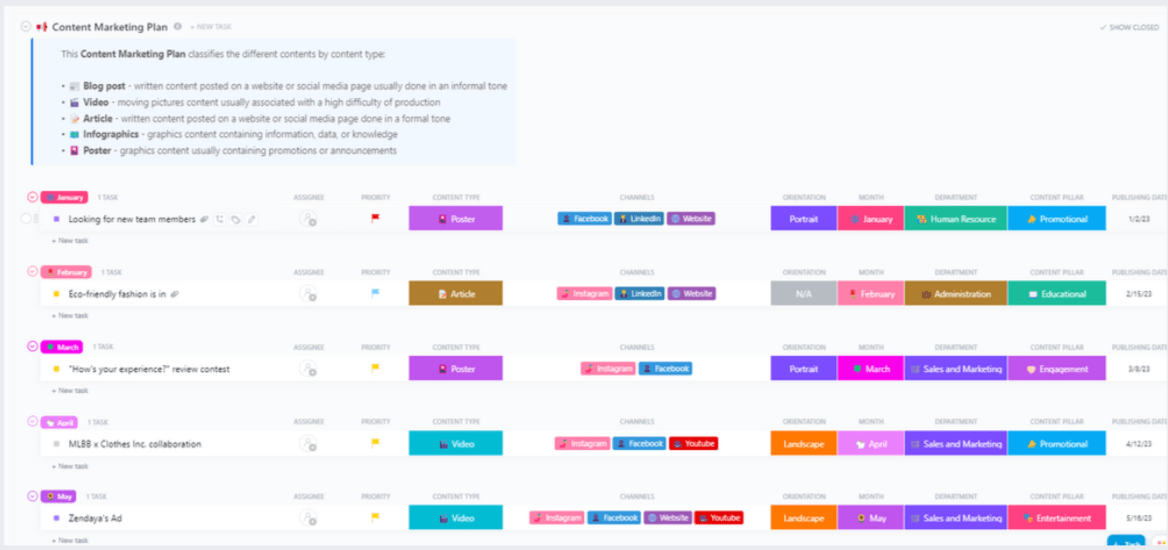
Step up your content planning game with ClickUp’s Content Marketing Plan Template
Once you’re aware of the audience and marketing space, start defining the ultimate goal you aim to achieve by the plan’s end, alongside intermediary milestones (e.g., Q1, Q2). This step establishes a clear trajectory for your content marketing strategy, providing a roadmap of incremental achievements throughout the decided timeline.
But before you delve into creating marketing goals, establish clear objectives. Determine whether your focus is generating leads, engaging existing customers with existing content, or expanding brand awareness. Emphasize setting SMART (Specific, Measurable, Realistic, and Time-bound) goals. This allows for the alignment of your marketing efforts and KPIs with the broader business vision, ensuring that your strategies resonate with key business priorities.
Consider using ClickUp Goals to streamline goal creation and tracking. This feature allows you to:

Set your goals and track your progress with ClickUp Goals
Your team can know when they’ve made good progress with ClickUp Milestones. The feature lets you group multiple tasks together and visualize core checkpoints. Remember that milestones should be clear and attainable to maintain team motivation.
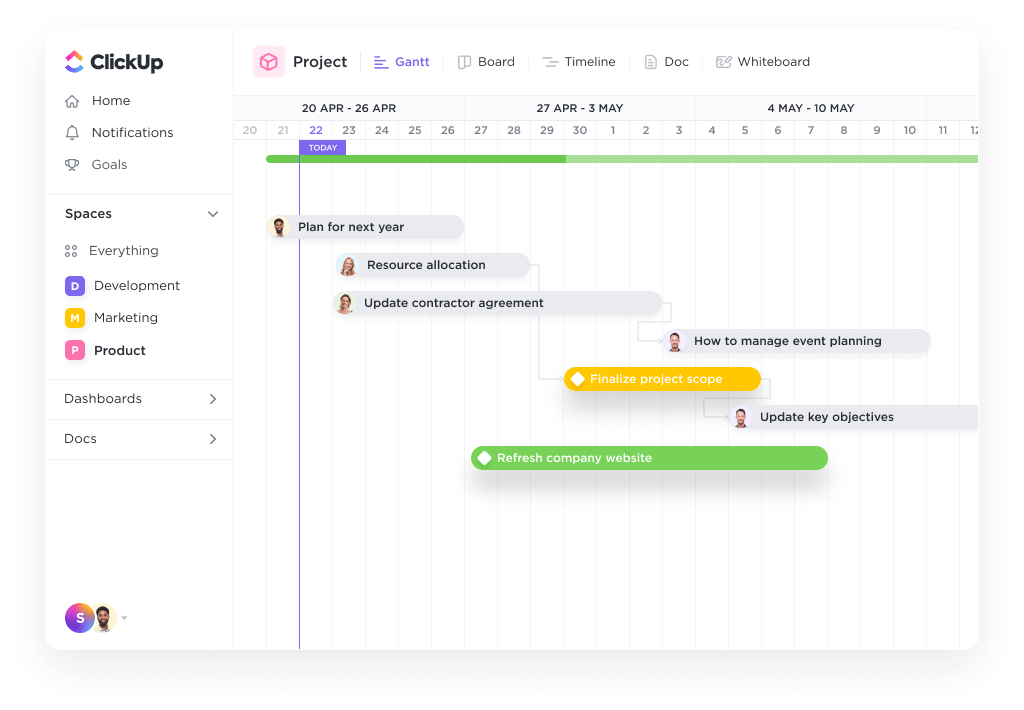
Visualize project Milestones with Gantt view in ClickUp
Enhance goal tracking further with tagging, dependency warnings, and ClickUp’s Time Tracking feature and always keep your marketing plans on track. 🏃
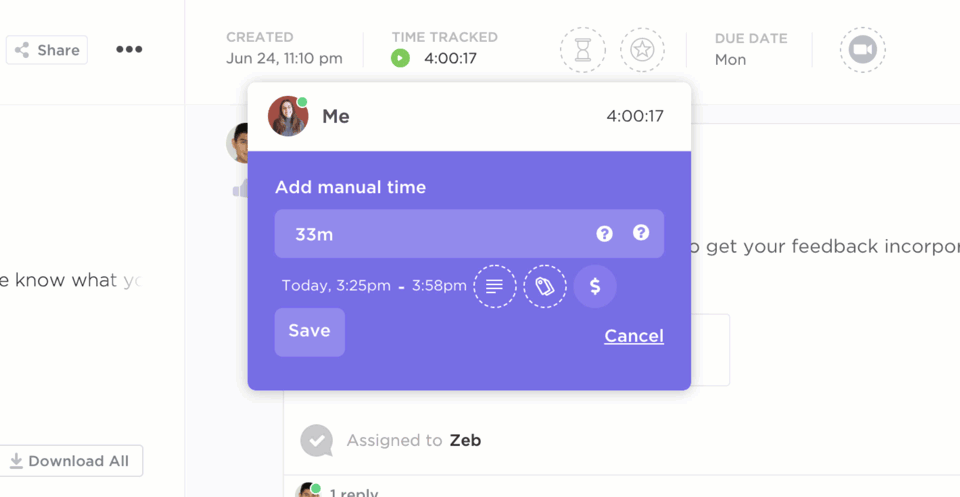
Record time as you go or enter it manually with time tracking in ClickUp
Translate goals into tasks. Build your roadmap’s stepping stones by addressing critical questions:
When you have your answers, allocate objective-specific tasks to each goal. Not sure how you’ll turn those goals into tasks? Simply navigate ClickUp Tasks and create a database of tasks and subtasks with assignees and due dates. You can filter each task by its type down the line.

Enhance clarity across your projects with customizable Task Types and improve organization across your task management efforts
That’s not all—you can have multiple perspectives on any task database on ClickUp through additional adjustable views, such as:
You can employ the ClickUp Kanban View Roadmap Template to manage tasks and targets efficiently. Its customizable interface facilitates accountability by assigning tasks to team members and allowing you to adjust timelines based on market dynamics and customer input. The template also offers Timeline and Team Workload views for swift workflow tracking.
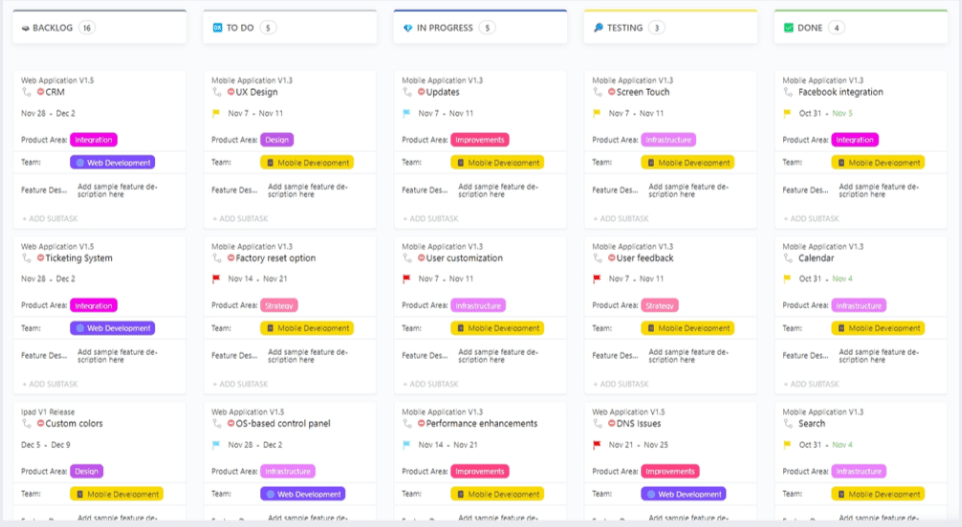
Stay on track and keep your goals in check with this visually appealing Kanban Roadmap Template by ClickUp
After setting your priorities and tasks, organizing them into a coherent schedule is crucial for maintaining the momentum of your marketing initiatives. ClickUp’s Content Calendar Template is designed to streamline your content planning and publication schedule.
This template allows you to visually plot your content across days, weeks, and months, ensuring a consistent flow of posts, articles, and promotional material.

Arrange marketing activities based on their anticipated impact versus input, prioritizing effectively. Consider the sequencing of initiatives and if it gives rise to any limitations or dependencies, especially concerning product launches or special events.
Establish timelines for each milestone to maintain the trajectory of your marketing initiatives. Ensure these timelines are realistic and align with your team’s resources and priorities.
You can employ estimation methods such as:

Quickly set Task Priority within a task to communicate what needs attention first
To speed up this process, leverage ClickUp Priorities to enhance team efficiency and resource management. This tool helps discern which ideas, concepts, tasks, or initiatives should be highlighted in four ways—Urgent, High, Normal, and Low, allowing for informed decisions.
Bonus: If you prefer more visual prioritization processes, you can also build a priority matrix using ClickUp Whiteboards.

ClickUp Whiteboards for Effective Project Management
Now that your content marketing roadmap is all finalized, revisit it for thorough analysis and identify the pivotal metrics essential for monitoring progress.
Quantify metrics for conversions, website traffic, social media engagement, and revenue and ensure they align with your success benchmarks.
Implement a standardized reporting structure at consistent intervals—weekly, monthly, or quarterly, using uniform criteria to factor in key trends and insights that may warrant roadmap adjustments.
Take advantage of ClickUp Dashboardsto streamline project reporting and task management. Use it to generate key reports (cards), add contextual notes, monitor live campaigns, and host discussions around adapting to shifting KPIs or team dynamics.
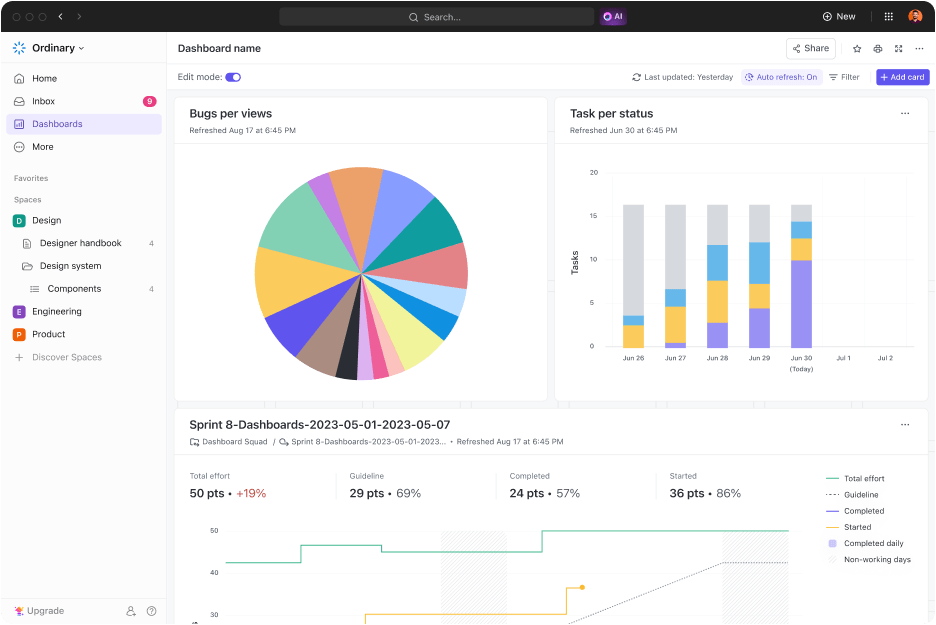
Create detailed Dashboards and easily add Cards to view sprint point progress, tasks per status, and bugs per view
ClickUp offers dozens of other functionalities and templates for a successful campaign. For instance, the comprehensive ClickUp Product Launch Checklist Template helps monitor multiple marketing stages—from design inception and prototype construction to customer reviews, promotional initiatives, and post-launch analysis.
Marketing teams can further benefit from the ClickUp Chat view. It helps cross-functional teams improve their collaborative effort through real-time conversations and comments within the Workspace, enhancing collaboration.

Add team members to discussions and collaborate with ClickUp Chat in one space and avoid hopping between software
There’s no one-size-fits-all formula when it comes to building a successful content marketing strategy. All things considered, you ultimately have to tailor it according to your target audience and company position. Here are a few examples to guide you:
For start-ups, especially in the digital space, speed and agility are key. This roadmap focuses on rapidly building an online presence through social media engagement, influencer partnerships, and targeted ad campaigns. It emphasizes leveraging real-time data to pivot and adapt strategy, ensuring that the brand stays relevant and competitive.
In the B2B sector, trust and credibility are paramount. This roadmap advocates for a content-driven approach, establishing thought leadership through whitepapers, case studies, and webinars. Strategic partnerships are leveraged to broaden reach and enhance brand authority, with a long-term focus on nurturing leads through personalized marketing automation.
For consumer-focused brands, this roadmap champions a customer-centric approach. It involves utilizing data analytics for personalized marketing across multiple channels, from email to social media. The emphasis is on creating a seamless, omnichannel consumer experience that strengthens brand loyalty and encourages repeat business.
A valid question many marketing teams have is: Is it worth investing in a roadmap when market conditions change frequently? Well, the adaptable and responsive nature of a content marketing roadmap ensures that when unexpected changes occur, the main goal can be refined accordingly.
Apart from this, content marketing roadmaps offer a multitude of benefits, such as:
Whether you’re a newcomer navigating the marketing world or a seasoned professional, content marketing roadmaps help in constructing a sustainable, lucrative strategy for your product or service.
Bid adieu to planning woes as you leverage ClickUp’s ready-made content marketing roadmap templates and all the tools for task management. Sign up for free today and take your first step toward making your marketing efforts thrive. 🌸
© 2025 ClickUp